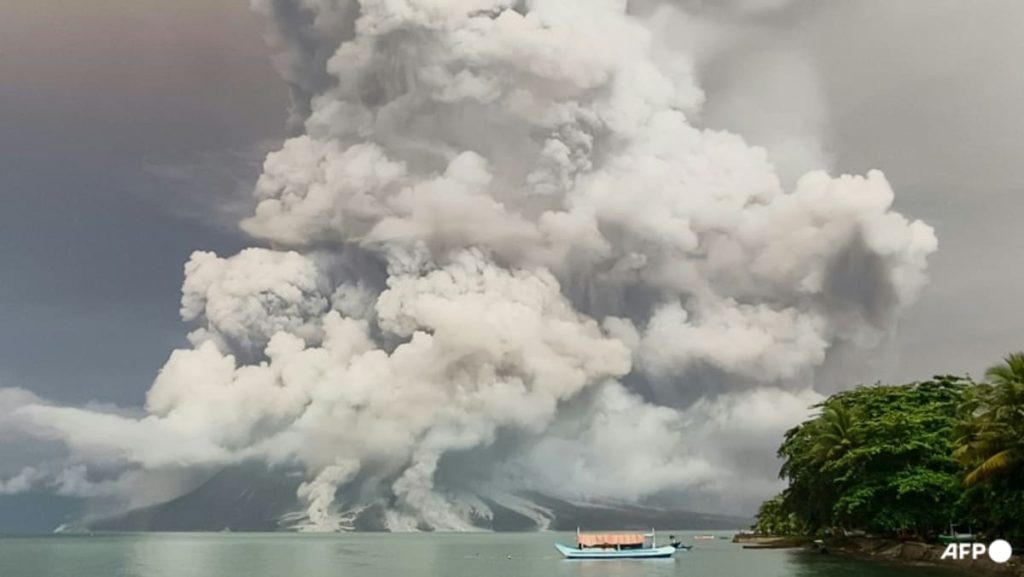ds of villagers from its slopes. Mount Sinabung on Sumatra island – which has been rumbling since 2010 and saw a deadly eruption in 2016 – spewed plumes of ash more than 7,000 metres into the air, the Indonesian disaster agency said. “The Transport Ministry will close seven airports due to the volcanic ash from Mount Sinabung,” agency spokesman Raditya Jati told AFP. Indonesia’s Volcanology and Geological Hazard Mitigation Centre said the ash cloud from the volcano had spread as far as 25km south, southeast, and east. The eruption lasted for just over 12 minutes, a local volcanology agency reported, adding that a thunderstorm occurred over the volcano immediately after the eruption.
The eruption forced the evacuation of more than 2,700 residents from 26 villages, although there were no reports of casualties, authorities said. Among those evacuated were villagers who had been displaced since the volcano became active more than a decade ago. Over the past few years, Mount Sinabung has seen sporadic eruptions, with the latest major one occurring in 2016 when seven people were killed. The volcano had been quiet for centuries before rumbling back to life in 2010, displacing tens of thousands and killing two people. The volcano is one of more than 120 active volcanoes in Indonesia, which is located on the Pacific Ring of Fire, an area with high volcanic and seismic activity. Sinabung is one of Indonesia’s most active volcanoes and has been erupting intermittently since 2013.
Indonesia is prone to volcanic eruptions and earthquakes due to its location on the Pacific Ring of Fire, an area with high volcanic and seismic activity. The archipelago nation is home to more than 130 active volcanoes and is situated on the edges of several tectonic plates, making it one of the most seismically active regions in the world. In December 2018, a tsunami triggered by the eruption of Anak Krakatau volcano killed more than 400 people and displaced thousands. In 2004, a massive earthquake off the coast of Sumatra triggered a tsunami that killed more than 230,000 people in a dozen countries. Indonesia has already faced multiple natural disasters this year, including flash floods, landslides, and earthquakes, which have killed dozens of people and displaced thousands.
Authorities have set up temporary shelters and provided assistance to those affected by the volcanic eruption. Evacuees have been housed in schools, government buildings, and other temporary shelters while waiting for the situation to stabilize. The government has also deployed military and police personnel to the affected areas to assist with the evacuation efforts and ensure the safety of residents. The Indonesian Red Cross has been providing food, water, and other essential supplies to evacuees, while local authorities have been monitoring the situation closely to assess the risk of further eruptions and determine when it will be safe for residents to return to their homes. Scientists are closely monitoring Mount Sinabung and are issuing regular updates to the public to keep them informed about the volcano’s activity and any potential hazards.
The eruption at Mount Sinabung has disrupted air travel in the region, with several airports forced to close due to the spread of volcanic ash. Flights have been canceled or diverted, affecting thousands of passengers and causing delays for airlines. The closure of airports has also disrupted the transportation of goods and supplies, impacting local businesses and communities that rely on air travel for trade and communication. Authorities are working to clean up the ash and ash clouds to allow airports to reopen safely and resume normal operations. The volcanic ash can pose a risk to aircraft by causing damage to engines and reducing visibility, making it unsafe to fly through. Airlines are closely monitoring the situation and adjusting their schedules accordingly to minimize disruptions for passengers and ensure their safety.
The eruption at Mount Sinabung serves as a reminder of the ongoing volcanic activity in Indonesia and the importance of being prepared for natural disasters. The country has a long history of volcanic eruptions, earthquakes, and tsunamis, which have caused significant damage and loss of life. Authorities are working to improve early warning systems, evacuation procedures, and disaster preparedness measures to mitigate the impact of future disasters and ensure the safety of residents. The eruption also highlights the need for international cooperation and support in responding to natural disasters, as Indonesia continues to face multiple challenges from climate change, deforestation, and environmental degradation. As the Indonesian government continues to monitor the situation at Mount Sinabung and provide assistance to those affected by the eruption, the country remains vigilant in preparing for future volcanic activity and other natural disasters that may occur in the region.















